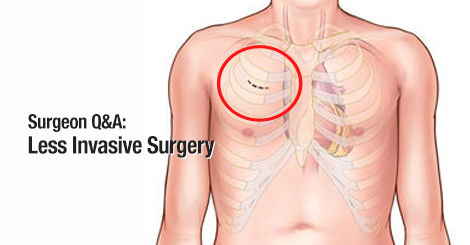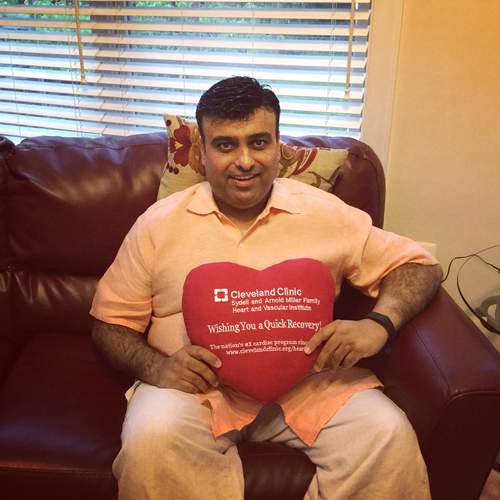Surgeon Q&A: “What’s the Latest Research About Less Invasive Aortic Valve Surgery?”
By Adam Pick on August 5, 2015
I get a lot of questions about aortic valve surgery. Lately, my inbox has swollen with questions about less invasive aortic valve procedures.

To get you the latest update on minimally invasive aortic valve surgery, I contacted Dr. Douglas Johnston.

So you know, Dr. Johnston is a great guy and has performed successful surgery on many patients in our community — including the recent success story of Sonny Abassi.

Dr. Douglas Johnston Says…
In my email to Dr. Johnston, I asked him: “Can you talk about the latest research and your clinical experience with less-invasive aortic valve therapy, including aortic valve repair and replacement? What do you see in the future for patients who need aortic valve surgery?”
In his response, Dr. Johnston wrote:
This is an exciting time for patients and surgeons in terms of aortic valve disease treatment, especially in the area of bicuspid valve disease. Last year, there were a number of important clinical and research developments related to this, all of which are positive for patients.
Our overall strategy for patients with aortic valve disease has always been to help them live long, healthy lives with as few changes to their regular lifestyle as possible. For a lot of people that means getting up and running as fast as possible after surgery and not having to take blood thinners once they are recovered.
We now have a lot of evidence from our own experience at Cleveland Clinic and from hospitals around the world that less-invasive valve surgery makes a real difference in early recovery. For 2 decades now, we have used a small incision in the upper sternum, the “J” incision, to perform aortic valve repair and replacement, and we have shown that this is a safe approach.
In the last 2 years ,we have begun performing “sternal sparing” aortic valve surgery, which uses an even smaller incision between the ribs. The early results with this incision are very encouraging. Patients are experiencing less pain and some are doing things like mountain biking within 3 weeks of surgery. Using advanced imaging like 3D CT scans to plan the surgery helps us perform these operations with maximum safety.
About 2% of the population is born with a bicuspid aortic valve. This condition is a common reason for aortic valve surgery. Patients coming to surgery tend to have either a valve leak (regurgitation) or a narrow valve (stenosis). Many patients with leaking aortic valves are able to have aortic valve repair. In 2014, one of my colleagues, Dr. Lars Svensson, published the results of more than 700 aortic valve repairs, which were associated with a very low mortality rate (less than ½ of one percent!) and very good long-term durability. Aortic valve repair is a great option for many patients with bicuspid aortic valves who have regurgitation.
There are a number of good options for patients who need an aortic valve replacement, either because their valve is narrow or because repair is not possible. We looked back at 30 years of experience with one of the most commonly used bovine aortic valves. This included more than 12,500 implants done at Cleveland Clinic. We found that long-term durability of the replacement valve is very good, even in young patients. For patients under age 50, the actual risk of needing another operation within 20 years was less than 1 in 5. These data make us very confident to use tissue valves in younger patients. These valves also help them to live as active a lifestyle as they want without the need to take Coumadin.
Finally, there are a lot of new valves coming into clinical use. Transcatheter aortic valves, which require the least invasive approach, have proven to be a good option for patients at high risk for open surgery. Newer generation tissue valves are making it possible for us to put valves in faster and easier, with more efficient blood flow, and greater expected durability. While nobody wants to think about having surgery on their aortic valve, there are a lot of options that will allow patients to live long, healthy lives without having to think too much about their valves!
I hope that helped you learn more about less invasive approaches for aortic valve surgery. Many, many, many thanks to Dr. Johnston for taking the time to share his research and clinical experiences with our community!
Keep on tickin!
Adam
|
Edith Dim says on August 7th, 2015 at 1:57 am |
|
I found Dr. johnson’s information about the less invasive approach to aortic valve replacement very interesting because I may be having the TAVR procedure in the near future. I have had two conflicting diagnosis, and will be having a third opinion on Sepember 3. At that time, I should know whether my aortic valve is severely calcified, or only moderately calcified. |
 |
|
Naomi Cohen Ivker says on August 7th, 2015 at 11:40 pm |
|
Thank you for this! I am having minimally invasive avr next week and the information available is scant. Plenty of information about avr but less about this approach. |
 |
|
bethmoore says on August 11th, 2015 at 11:55 pm |
|
For sure if possible get the operation thru your ribs, I have a pretty 9 inch crooked incision on my chest & when they say 6 months to recover they aren’t kidding I went back to work 7 wks later & have been very sorry. I’ll be glad when the area above my boobs aren’t so tender when my cats walk across me. |
 |
|
Doug Manson says on August 27th, 2015 at 3:19 pm |
|
What makes you a good candidate for for the less invasive Aortic replacement surgery |
 |












